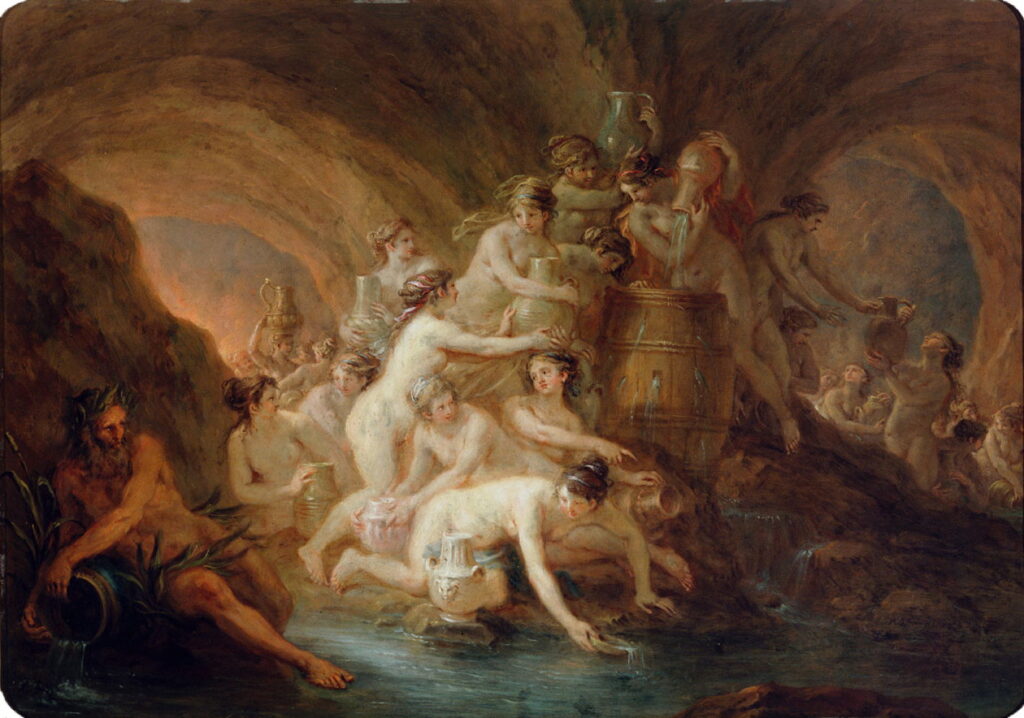Heroines 14: The crime of faithfulness

Stories of the abduction of women and their enforced marriage have persisted for an extraordinary length of time. One of the most popular, and still much-loved, musicals is Seven Brides for Seven Brothers, a successful movie in 1954, and as late as 1982-83 it was remade for television. It tells of seven ‘shotgun’ marriages, and was based on a short story The Sobbin’ Women, which in turn was a parody of the story of the rape of the Sabine women in about 750 BCE.
As popular in classical Greek and Roman times was an equally disturbing myth concerning Hypermnestra and her sisters the Danaïds, which was largely forgotten after the Middle Ages, only to be revived around the start of the twentieth century. It was told by Hyginus, Apollodorus, Aeschylus, and Horace, and referred to by many others.
Danaus and Aegyptus were twin brothers who lived in North Africa. Aegyptus was a mythical king of Egypt who had fifty sons, and his brother had fifty daughters, from their polygamous relationships. When Aegyptus decided that his sons would marry his brother’s daughters, Danaus fled with those daughters to Argos, in Greece, where the reigning king generously handed over his throne to him.
Aegyptus and his sons were not to be put off so easily, joined Danaus and his daughters in Argos, and pressed ahead with the plans for the weddings. The couples were assigned by lot, apart from two matches between Hypermnestra and Lynceus, and Gorgophone and Proteus, deemed necessary because of the rank of their mothers, who were princesses.
On the day of their weddings, Danaus equipped his daughters with swords, and told them to murder their husbands in bed that night. Once those drunken grooms had fallen asleep, the daughters each followed their father’s instructions, except for Hypermnestra: by the morning, of the fifty brothers only Lynceus survived.
Artist not known, Hypermnestra, Lynceus (or Linus) and the Danaïdes (1473), hand coloured woodcut from Giovanni Boccaccio’s De mulieribus claris, translated by Heinrich Steinhöwel and printed by Johannes Zainer at Ulm c 1474, Penn Libraries call number: Inc B-720, Philadelphia, PA. Image by kladcat, via Wikimedia Commons.
This story was told in the fourteenth of Giovanni Boccaccio’s De Mulieribus Claris (Concerning Famous Women), published in 1374, and illustrated as Hypermnestra, Lynceus and the Danaïdes (1473) in this hand coloured woodcut from the translation by Heinrich Steinhöwel. Four of the brothers are seen, their throats cut in bed, but the helpfully labelled figures of Hypermnestra and ‘Linus’ are still in a loving embrace.
Robinet Testard (fl. 1470-1531), The Danaides Kill Their Husbands (c 1510), miniature in Héroïdes ou Epîtres, by Ovid, translated by Octavien de Saint-Gelais, Bibliothèque nationale de France (Français 874, Folio 170v), Paris. Wikimedia Commons.
Robinet Testard shows a similar scene in The Danaides Kill Their Husbands (c 1510), his miniature for Octavien de Saint-Gelais’ translation of Ovid’s Heroides. Hypermnestra’s sisters have each dutifully cut the throats of their new husbands, and sit holding their swords. At the left, though, Hypermnestra and Lynceus sit together on their marriage bed, unharmed.
Danaus was furious with the disobedience of Hypermnestra, who was dragged to a dungeon by her hair to await her fate. It’s at this point that Ovid set his fictional letter from Hypermnestra to Lynceus, the fourteenth letter in his Heroines.
Ovid’s Hypermnestra makes it clear from the outset that she has been charged with the crime of faithfulness, which should surely be praised, not condemned. She reveals the quandary that she found herself in, as she held her father’s sword at the neck of Lynceus and agonised over whether she should kill him or not. Three times she raised the sword in preparation for his murder, and three times her love for Lynceus overpowered her, and spared his life.
Hypermnestra was not summarily executed by her father, but brought before a court, which acquitted her of any wrongdoing. Lynceus (sometimes erroneously named Linus) then killed Danaus, and succeeded him as the King of Argos with Hypermnestra as his queen.
Francesco Xanto Avelli (c 1487–1542), Hypermnestra Watching Lynceus Take Her Father’s Crown (1537), earthenware plate with tin glaze (maiolica), 2.3 × 25.5 cm, Walters Art Museum, Baltimore, MD. Wikimedia Commons.
This maiolica plate painted by Francesco Xanto Avelli in 1537 shows the later scene of Hypermnestra Watching Lynceus Take Her Father’s Crown. Lynceus (labelled here as ‘Lino’) has taken Danaus’ crown, and is about to put him to the sword. Hypermnestra stands at a window, most probably not that of a dungeon. Below its lintel is a Cupid bearing the famous saying omnia vincit amor – love conquers all – which actually comes from Virgil’s last Eclogue and is unrelated.
In the end, while Lynceus and Hypermnestra lived happily ever after, the other forty-nine sisters were punished in Hades for the sin of murder. They were given an impossible task, of filling a large container with water; as that container had holes in its bottom, they now spend the rest of eternity carrying water to the container and pouring it in.
Unlike the hapless Sisyphus, who was condemned to push a hefty rock up a steep hill in his Sisyphean task, the Danaïds haven’t been commemorated in figurative language, but have appeared in a surprising number of paintings.
Martin Johann Schmidt (1718–1801), The Labour of the Danaides (1785), oil on copper plate, 54.5 × 77 cm, Narodna galerija Slovenije, Ljubljana, Slovenia. Wikimedia Commons.
The murderous sisters don’t seem to have had much of a showing in art until Martin Johann Schmidt painted The Labour of the Danaides (1785) on copper. He makes the allusion to Danaïds also being known as water-nymphs, like Naiads, by placing a river god at the left.
John William Waterhouse (1849–1917), The Danaides (1903), oil on canvas, 111 × 154.3 cm, Private collection. Wikimedia Commons.
John William Waterhouse revived them for two paintings, of which this, The Danaides, was the first, and completed in 1903. He made a second slightly more complex composition in 1906, now hanging in Aberdeen Art Gallery in Scotland. Rather than a battered and leaky barrel, Waterhouse has the Danaïds filling an ornamental cauldron.
Walter Crane (1845-1915), The Danaides (date not known), further details not known. Wikimedia Commons.
I have been unable to find a date for Walter Crane’s version, The Danaides, which was probably for a triptych painted between 1890-1915 and shows a remarkably similar cauldron.
John Singer Sargent (1856–1925), The Danaïdes (c 1922-25), oil on canvas, 335.28 x 632.46 cm, Museum of Fine Arts, Boston, MA. Wikimedia Commons.
Towards the end of his life, John Singer Sargent painted this vast canvas to show The Danaïdes (c 1922-25), now decorating the entrance to the Library of the Museum of Fine Arts in Boston.
Of all the accounts of this unusual myth, yet again only Ovid looks deep into the relationships involved. He explores the situation of a woman who didn’t commit a crime at her father’s behest, but stayed true to her morals and to her love for Lynceus: a real heroine whose virtue was, for once, rewarded.




